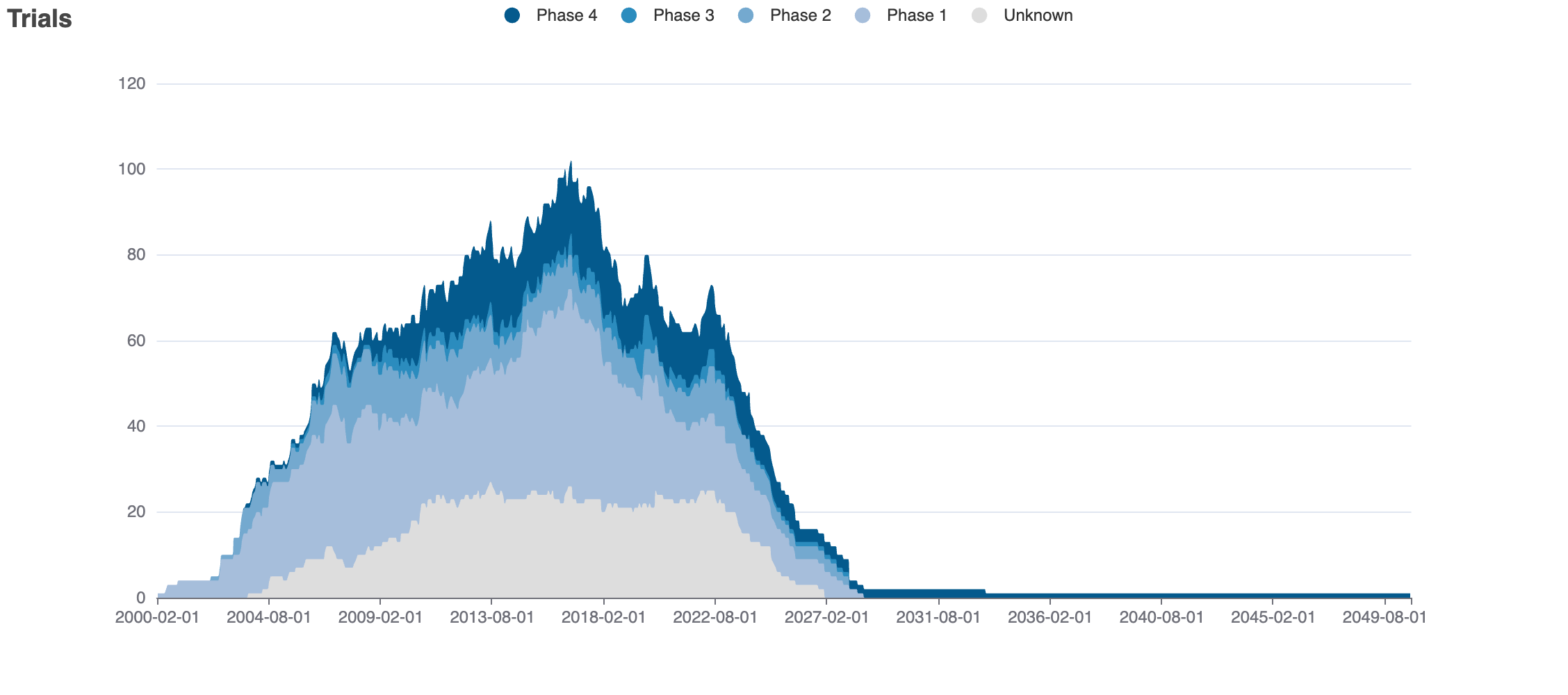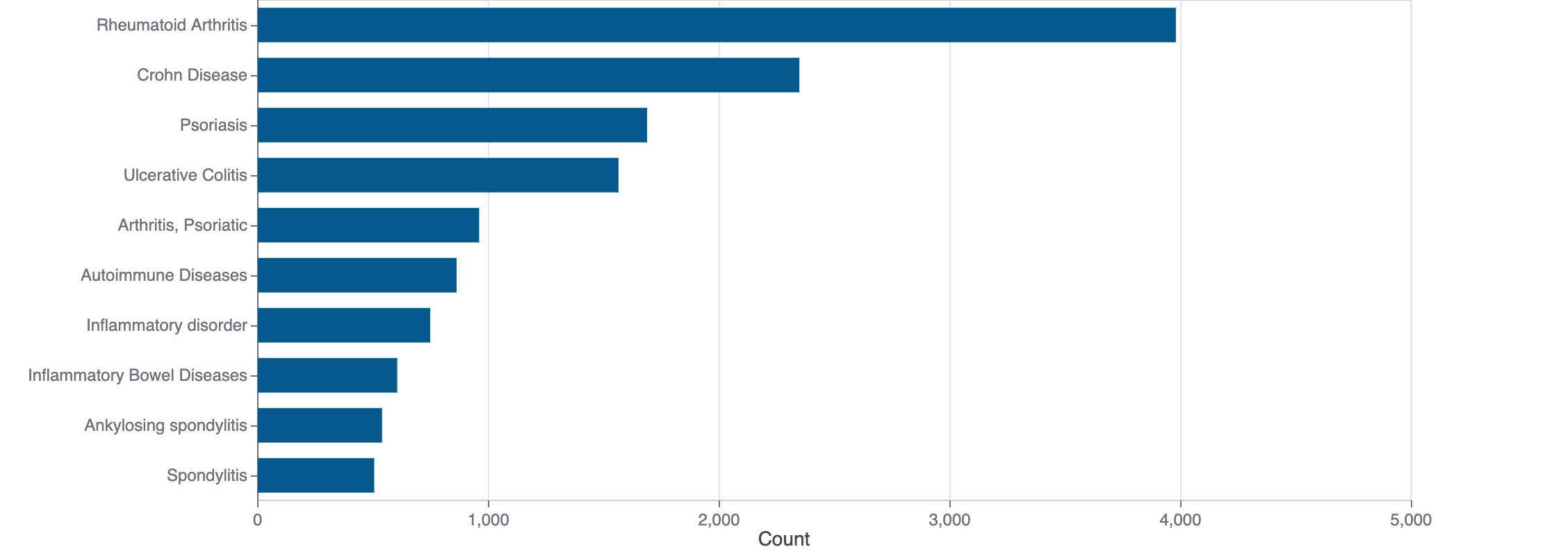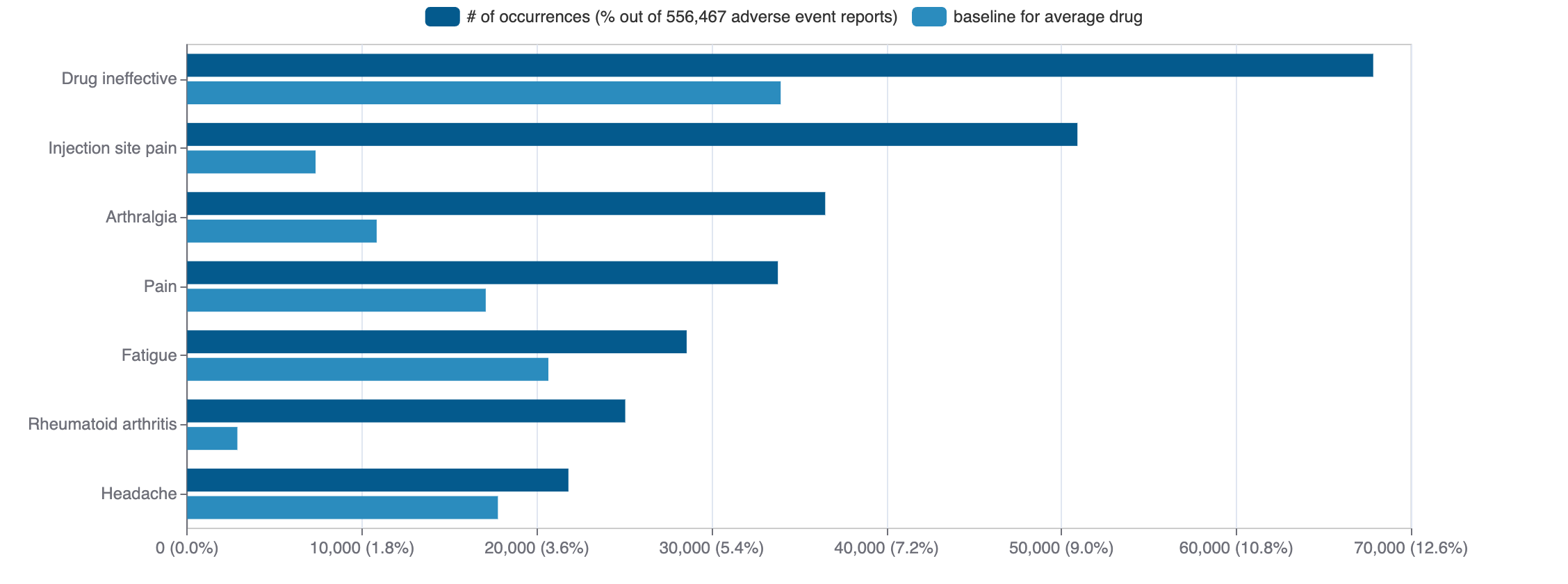Vanflyta(quizartinib)
Vanflyta (quizartinib) is a small molecule pharmaceutical. Quizartinib was first approved as Vanflyta on 2023-07-20. It is used to treat myeloid leukemia acute in the USA. It has been approved in Europe to treat myeloid leukemia. The pharmaceutical is active against receptor-type tyrosine-protein kinase FLT3. In addition, it is known to target macrophage colony-stimulating factor 1 receptor, platelet-derived growth factor receptor alpha, proto-oncogene tyrosine-protein kinase receptor Ret, mast/stem cell growth factor receptor Kit, and platelet-derived growth factor receptor beta.
Download report
Favorite
Events Timeline
Commercial
Clinical
Drug
Target
Variants
Financial
Trends
Safety
Events Timeline
5D
1M
3M
6M
YTD
1Y
2Y
5Y
Max
Events
FDA approval date
EMA approval date
Patent expiration date
Study first post date
Last update post date
Start date
Primary completion date
Completion date
Results first post date

Mock data
Subscribe for the real data
Subscribe for the real data
Commercial
Therapeutic Areas
Therapeutic Area | MeSH |
|---|---|
| neoplasms | D009369 |
| hemic and lymphatic diseases | D006425 |
Trade Name
FDA
EMA
Vanflyta
Drug Products
FDA
EMA
New Drug Application (NDA)
New Drug Application (NDA)
Abbreviated New Drug Application (ANDA)
Abbreviated New Drug Application (ANDA)
Quizartinib dihydrochloride
Tradename | Company | Number | Date | Products |
|---|---|---|---|---|
| VANFLYTA | Daiichi Pharmaceutical | N-216993 RX | 2023-07-20 | 2 products, RLD, RS |
Labels
FDA
EMA
Brand Name | Status | Last Update |
|---|---|---|
| vanflyta | New Drug Application | 2025-11-12 |
Indications
FDA
EMA
Indication | Ontology | MeSH | ICD-10 |
|---|---|---|---|
| myeloid leukemia acute | — | D015470 | C92.0 |
Agency Specific
FDA
EMA
Expiration | Code | ||
|---|---|---|---|
QUIZARTINIB DIHYDROCHLORIDE, VANFLYTA, DAIICHI SANKYO INC | |||
| 2030-07-20 | ODE-437 | ||
| 2028-07-20 | NCE | ||
Patent Expiration
Patent | Expires | Flag | FDA Information |
|---|---|---|---|
| Quizartinib Dihydrochloride, Vanflyta, Daiichi Sankyo Inc | |||
| 9675549 | 2033-09-30 | DP | |
| 8357690 | 2031-02-26 | U-3661 | |
| 9555040 | 2030-05-14 | U-3661 | |
| 8836218 | 2030-03-23 | U-3661 | |
| 7968543 | 2029-08-15 | DP | U-3661 |
| 8865710 | 2029-08-15 | DP | |
| 7820657 | 2028-09-26 | DP | |
| 8129374 | 2027-03-16 | U-3661 | |
| 8557810 | 2027-03-16 | DP | |
| 8883783 | 2027-03-16 | DP | |
| 9585892 | 2027-03-16 | U-3661 | |
HCPCS
No data
Clinical
Clinical Trials
49 clinical trials
View more details

Mock data
Subscribe for the real data
Subscribe for the real data
Indications Phases 4
No data
Indications Phases 3
Indication | MeSH | Ontology | ICD-10 | Ph 1 | Ph 2 | Ph 3 | Ph 4 | Other | Total |
|---|---|---|---|---|---|---|---|---|---|
| Myeloid leukemia acute | D015470 | — | C92.0 | 19 | 18 | 5 | — | 3 | 34 |
| Leukemia | D007938 | — | C95 | 14 | 14 | 4 | — | 2 | 26 |
| Myeloid leukemia | D007951 | — | C92 | 13 | 13 | 2 | — | 2 | 22 |
| Myelodysplastic syndromes | D009190 | — | D46 | 9 | 8 | 1 | — | — | 10 |
| Preleukemia | D011289 | — | — | 4 | 4 | 1 | — | — | 5 |
Indications Phases 2
Indication | MeSH | Ontology | ICD-10 | Ph 1 | Ph 2 | Ph 3 | Ph 4 | Other | Total |
|---|---|---|---|---|---|---|---|---|---|
| Syndrome | D013577 | — | — | 4 | 3 | — | — | — | 4 |
| Myelomonocytic leukemia chronic | D015477 | — | C93.1 | 2 | 2 | — | — | — | 2 |
| Recurrence | D012008 | — | — | 2 | 1 | — | — | — | 2 |
| Myeloproliferative disorders | D009196 | — | D47.1 | 1 | 1 | — | — | — | 1 |
| Myelomonocytic leukemia acute | D015479 | — | C92.5 | 1 | 1 | — | — | — | 1 |
| Myelomonocytic leukemia juvenile | D054429 | — | C93.3 | 1 | 1 | — | — | — | 1 |
| Biphenotypic leukemia acute | D015456 | — | C95.0 | 1 | 1 | — | — | — | 1 |
| Promyelocytic leukemia acute | D015473 | — | C92.4 | — | 1 | — | — | — | 1 |
Indications Phases 1
Indication | MeSH | Ontology | ICD-10 | Ph 1 | Ph 2 | Ph 3 | Ph 4 | Other | Total |
|---|---|---|---|---|---|---|---|---|---|
| Healthy volunteers/patients | — | — | — | 5 | — | — | — | — | 5 |
| Pharmacokinetics | D010599 | — | — | 2 | — | — | — | — | 2 |
| Drug interactions | D004347 | — | — | 2 | — | — | — | — | 2 |
| Neoplasms | D009369 | — | C80 | 2 | — | — | — | — | 2 |
| Hepatic insufficiency | D048550 | — | — | 2 | — | — | — | — | 2 |
| Precursor cell lymphoblastic leukemia-lymphoma | D054198 | — | C91.0 | 1 | — | — | — | — | 1 |
| Liver diseases | D008107 | EFO_0001421 | K70-K77 | 1 | — | — | — | — | 1 |
| Hematologic neoplasms | D019337 | — | — | 1 | — | — | — | — | 1 |
| Myeloid sarcoma | D023981 | — | C92.3 | 1 | — | — | — | — | 1 |
Indications Without Phase
Indication | MeSH | Ontology | ICD-10 | Ph 1 | Ph 2 | Ph 3 | Ph 4 | Other | Total |
|---|---|---|---|---|---|---|---|---|---|
| Peripheral arterial disease | D058729 | EFO_0004265 | — | — | — | — | — | 1 | 1 |
| Peripheral vascular diseases | D016491 | EFO_0003875 | I73.9 | — | — | — | — | 1 | 1 |
| Diabetic foot | D017719 | EFO_1001459 | — | — | — | — | — | 1 | 1 |
| Ulcer | D014456 | MPATH_579 | — | — | — | — | — | 1 | 1 |
| Foot ulcer | D016523 | — | — | — | — | — | — | 1 | 1 |
Epidemiology
Epidemiological information for investigational and approved indications
View more details
Drug
General
| Drug common name | Quizartinib |
| INN | quizartinib |
| Description | Quizartinib is a member of the class of phenylureas that is urea in which one of the amino groups has been substituted by a 5-tert-butyl-1,2-oxazol-3-yl group while the other has been substituted by a phenyl group substituted at the para- position by an imidazo[2,1-b][1,3]benzothiazol-2-yl group that, in turn, is substituted at position 7 by a 2-(morpholin-4-yl)ethoxy group. It has a role as an EC 2.7.10.1 (receptor protein-tyrosine kinase) inhibitor, an antineoplastic agent and a necroptosis inhibitor. It is a benzoimidazothiazole, a member of morpholines, a member of isoxazoles and a member of phenylureas. |
| Classification | Small molecule |
| Drug class | tyrosine kinase inhibitors |
| Image (chem structure or protein) |  |
| Structure (InChI/SMILES or Protein Sequence) | CC(C)(C)c1cc(NC(=O)Nc2ccc(-c3cn4c(n3)sc3cc(OCCN5CCOCC5)ccc34)cc2)no1 |
Identifiers
| PDB | — |
| CAS-ID | 950769-58-1 |
| RxCUI | — |
| ChEMBL ID | CHEMBL576982 |
| ChEBI ID | 90217 |
| PubChem CID | 24889392 |
| DrugBank | DB12874 |
| UNII ID | 7LA4O6Q0D3 (ChemIDplus, GSRS) |
Target
Agency Approved
No data
Alternate
RET
RET
Organism
Homo sapiens
Gene name
RET
Gene synonyms
CDHF12, CDHR16, PTC, RET51
NCBI Gene ID
Protein name
proto-oncogene tyrosine-protein kinase receptor Ret
Protein synonyms
Cadherin family member 12, cadherin-related family member 16, Proto-oncogene c-Ret, rearranged during transfection, ret proto-oncogene (multiple endocrine neoplasia and medullary thyroid carcinoma 1, Hirschsprung disease), RET receptor tyrosine kinase
Uniprot ID
Mouse ortholog
Ret (19713)
proto-oncogene tyrosine-protein kinase receptor Ret (P35546)
Variants
No data
Financial
No data
Trends
PubMed Central
Top Terms for Disease or Syndrome:

Mock data
Subscribe for the real data
Subscribe for the real data
Additional graphs summarizing 2,336 documents
View more details
Safety
Black-box Warning
Black-box warning for: Vanflyta
Adverse Events
Top Adverse Reactions

Mock data
Subscribe for the real data
Subscribe for the real data
364 adverse events reported
View more details
© 2020-2025 Collaborative Drug Discovery Inc. (CDD) | Terms of Use